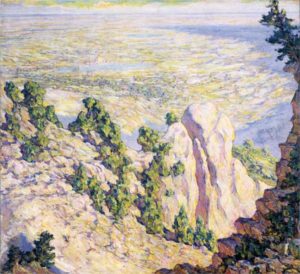
View from a Mountaintop by Robert Lewis Reid
by Barrie
You climb the mountain to be able to look over the whole situation, not bound by one side or the other. —Thich Nhat Hanh, The Heart of the Buddha’s Teaching
Isn’t this a wonderful image to describe the vantage point we can gain in yoga?
Through meditation, we can ascend to a more expansive vista within our minds. There, we can observe ourselves and the contours of our lives with the freedom afforded by a broader vision and a healthy bit of detachment.
Meditation isn’t necessarily about quieting your mind; it’s about developing a new relationship with your mind. That’s what the view from the mountaintop is, a perspective that’s bigger than what our minds might tend to tell us.
The first step is becoming self-aware. Here’s one simple way to practice this: When you sit for meditation, imagine yourself standing on a mountaintop looking down from above. Notice what this perspective feels like. For me, it often feels as if my awareness has expanded like a camera lens zooming out to take in a larger view in my mind’s eye.
As you notice this experience for yourself, the next step is to become aware of that awareness that’s looking out at the scene below. Getting to know that part of your mind and returning to that watchful stance is the ongoing work of the meditator.
As we hone this self-reflective capacity—that distinctly human ability to know what we’re thinking —we gain a more spacious (and probably wiser) outlook on ourselves and our lives.
We become temporarily free from the confines of our thoughts, opinions, beliefs, or even the usual ways we define ourselves. We rise above the divisiveness and constriction of ordinary awareness and look out from that all-encompassing view that contains everything yet remains unaffected by it.
This alone has the potential to shift how you act and how you are in the world.
But there’s more. Because the view from the mountaintop doesn’t just stay there. Each time you notice your thoughts in meditation and bring yourself back to your breath or your chosen object of focus, you strengthen the muscle of your self-awareness, practicing what meditation teacher Dan Harris calls a “bicep curl for the brain.”
Here’s how to practice: start by noticing, even naming, the thoughts and feelings that are arising. After that comes the most important part—recognizing that moment as an opportunity to return your awareness to the present, rather than judging yourself. As much as possible, gently and lovingly bring yourself back to your breath, your mantra, or any other focusing technique that works for you.
When you come down from the climb, as it were, and move on with your day, that spacious perspective is still possible, isn’t it?
When you are speaking with another person, or doing your work, you can mentally “zoom out” by becoming aware of your peripheral vision. You are still fully present with whatever you are doing, but your awareness is expanded to include you as well as the whole scene in that moment, as if you were watching from the mountaintop.
The self-awareness you build through your practice stays with you. You can use it to live with greater consciousness and equanimity.
Download Barrie’s free Guide to Home Yoga Practice right here. Learn more about her book Evolving Your Yoga: Ten Principles for Enlightened Practice and her online classes at www.barrierisman.com.
• Follow Yoga for Healthy Aging on Facebook and follow Nina on Instagram • Pre-order Yoga for Times of Change: Practices and Meditations for Moving Through Stress, Anxiety, Grief & Life’s Transitions here • Order Yoga for Healthy Aging: A Guide to Lifelong Well-Being here


Leave A Comment